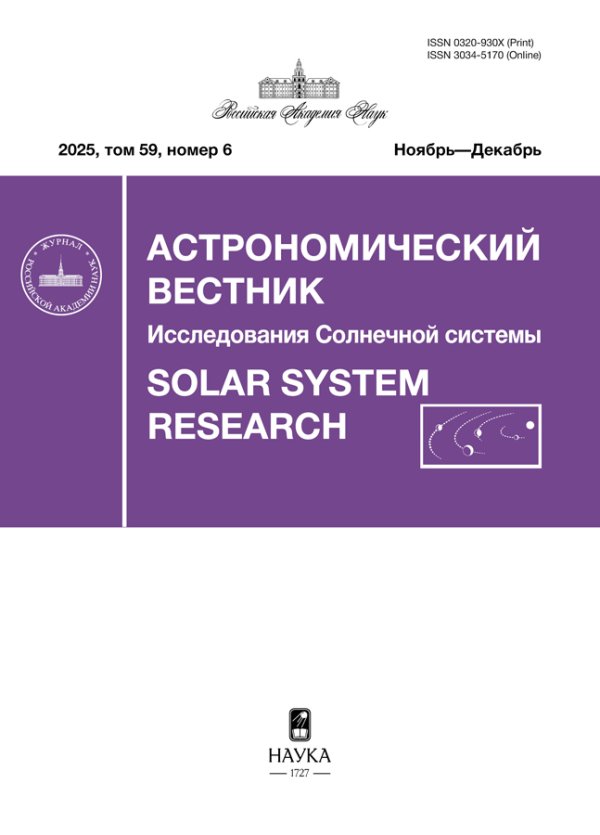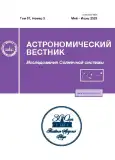Stable Orbits in the Feeding Zone of the Planet Proxima Centauri c
- Authors: Ipatov S.I.1
-
Affiliations:
- Vernadsky Institute of Geochemistry and Analytical Chemistry, Russian Academy of Sciences, Moscow, Russia
- Issue: Vol 57, No 3 (2023)
- Pages: 248-261
- Section: Articles
- URL: https://journals.rcsi.science/0320-930X/article/view/134967
- DOI: https://doi.org/10.31857/S0320930X23030039
- EDN: https://elibrary.ru/HYSOIV
- ID: 134967
Cite item
Full Text
Abstract
Estimates of the size of the feeding zone of the planet Proxima Centauri c have been made at initial orbital eccentricities of planetesimals equal to 0.02 or 0.15. The research is based on the results of modeling of the evolution of planetesimals’ orbits under the influence of the star and planets Proxima Centauri c and b. The considered time interval reached a billion years. It was found that after the accumulation of the planet Proxima Centauri c some planetesimals may have continued to move in stable elliptical orbits within its feeding zone, largely cleared of planetesimals. Usually such planetesimals can move in some resonances with the planet (Proxima Centauri c), for example, in the resonances 1 : 1 (as Jupiter Trojans), 5 : 4 and 3 : 4 and usually have small eccentricities. Some planetesimals that moved for a long time (1–2 million years) along chaotic orbits fell into the resonances 5 : 2 and 3 : 10 with the planet Proxima Centauri c and moved in them for at least tens of millions of years.
About the authors
S. I. Ipatov
Vernadsky Institute of Geochemistry and Analytical Chemistry, Russian Academy of Sciences, Moscow, Russia
Author for correspondence.
Email: siipatov@hotmail.com
Россия, Москва
References
- Брюно А.Д. Ограниченная задача трех тел. Плоские периодические орбиты. М.: Наука, 1990. 295 с.
- Демидова Т.В., Шевченко И.И. Долговременная динамика планетезималей в хаотических зонах планет // Письма в Астрон. журн. 2020. Т. 46. № 11. С. 827–836
- Демидова Т.В., Шевченко И.И. Эволюция хаотических зон планет в планетезимальных дисках // Письма в Астрон. журн. 2021. Т. 47. № 11. С. 800–811.
- Ипатов С.И. О гравитационном взаимодействии двух планетезималей // Астрон. журн. 1981. Т. 58. № 3. С. 620–629.
- Ипатов С.И. Изменения эксцентриситетов орбит астероидного типа в окрестности резонанса 2 : 5 // Письма в Астрон. журн. 1989. Т. 15. № 8. С. 750–760.
- Ипатов С.И. Изменения элементов орбит астероидного типа при резонансе 2 : 5 // Астрон. вестн. 1992. Т. 26. № 6. С. 26–53. (Ipatov S.I. Numerical model of the evolution of asteroid orbits at the 2 : 5 resonance // Sol. Syst. Res. 1992. V. 26. № 6. P. 520–541.)
- Ипатов С.И. Миграция тел в процессе аккумуляции планет // Астрон. вестн. 1993. Т. 27. № 1. С. 83–101. (Ipatov S.I. Migration of bodies in the accretion of planets // Sol. Syst. Res. 1993. V. 27. № 1. P. 65–79.)
- Ипатов С.И. Гравитационное взаимодействие двух планетезималей, движущихся по близким орбитам // Астрон. вестн. 1994. Т. 28. № 6. С. 10–33. (Ipatov S.I. Gravitational interaction of two planetesimals moving in close orbits // Sol. Syst. Res. 1994. V. 28. № 6. P. 494–512. https://www.academia.edu/44448100/Gravitational _interaction_of_two_planetesimals_moving_in_close_orbits.)
- Ипатов С.И. Миграция небесных тел в Солнечной системе. М.: Изд-во УРСС, 2000. 320 с. Изд. стереотип. М.: URSS (Ленанд), 2021. 320 с. https://doi.org/10.17513/np.451.
- Маркеев А.П. Точки либрации в небесной механике и космодинамике. М.: Наука, 1978. 312 с.
- Artymowicz P. Self regulating protoplanet growth // Icarus. 1987. V. 70. P. 303–318.
- Birn J. On the stability of the planetary system // Astron. and Astrophys. 1973. V. 24. P. 283–293.
- Demidova T.V., Shevchenko I.I. Three-lane and multilane signatures of planets in planetesimal disks // Mon. Notic. Roy. Astron. Soc. 2016. V. 463. P. L22–L25.
- Dermott S.F. The dynamics of tadpole and horseshoe orbits. I. Theory // Icarus. 1981a. V. 48. № 1. P. 1–11.
- Dermott S.F. The dynamics of tadpole and horseshoe orbits. II. The coorbital satellites of Saturn // Icarus. 1981b. V. 48. P. 12–22.
- Duncan M.J., Quinn T., Tremaine S. The long-term evolution of orbits in the Solar System: a mapping approach // Icarus. 1989. V. 82. P. 402–418.
- Dvorak R., Kubala M. Are the long-living Hilda-like asteroids between Jupiter and Saturn? // Astron. Nachr. 2022. V. 343. id. e220009 (13 p.). https://doi.org/10.1002/asna.20220009
- Farinella P., Froeschlé Ch., Froeschlé C., Gonczi R., Hahn G., Morbidelli A., Valsecchi G.B. Asteroids falling onto the Sun // Nature. 1994. V. 371. P. 314–317.
- Frantseva K., Nesvorný D., Mueller M., van der Tak F.F.S., ten Kate I.L., Pokorný P. Exogenous delivery of water to Mercury // Icarus. 2022. V. 383. id. 114980 (11 p.).
- Gladman B. Dynamics of systems of two close planets // Icarus. 1993. V. 106. № 1. P. 247–263.
- Gladman B., Duncan M. On the fates of minor bodies in the outer Solar System // Astron. J. 1990. V. 100. № 5. P. 1680–1693.
- Goldreich P., Tremaine S. The dynamics of planetary rings // Annu. Rev. Astron. and Astrophys. 1982. V. 20. P. 249–284.
- Goldberg M., Batygin K., Morbidelli A. A criterion for the stability of planets in chains of resonances // Icarus. 2022. V. 388. id. 115206 (6 p.).
- Gratia P., Lissauer J.J. Eccentricities and the stability of closely-spaced five-planet systems // Icarus. 2020. V. 358. id. 114038 (9 p.).
- Greenzweig Y., Lissauer J.J. Accretion rates of protoplanets. II. Gaussian distribution of planetesimal velocities // Icarus. 1992. V. 100. P. 440–463.
- Hasegawa M., Nakazawa K. Distant encounter between Keplerian particles // Astron. and Astrophys. 1990. V. 227. P. 619–627.
- Holt T.R., Nesvorný D., Horner J., King R., Marschall R., Kamrowski M., Carter B., Brookshaw L., Tylor C. Stability of Jovian Trojans and their collisional families // Mon. Notic. Roy. Astron. Soc. 2020. V. 495. P. 4085–4097. https://doi.org/10.1093/mnras/staa1348
- Ida S., Nakazawa K. Collisional probability of planetesimals revolving in the solar gravitational field. III // Astron. and Astrophys. 1989. V. 224. P. 303–315.
- Ipatov S.I. Evolution of asteroidal orbits at the 5 : 2 resonance // Icarus. 1992. V. 95. P. 100–114.
- Ipatov S.I. Delivery of water and volatiles to planets in the habitable zone in the Proxima Centauri system // Abstracts of the AASTCS Habitable Worlds 2021 Workshop (22–26 February 2021, a virtual conference). Open Engagement Abstracts, Bulletin of the American Astronomical Society, 2021. V. 53. № 3. id 2021n3i1126 (5 p.) https://baas.aas.org/pub/2021n3i1126/release/2.
- Ipatov S.I. Scattering of planetesimals from the feeding zone of Proxima Centauri c // Thirteenth Moscow Solar System Symposium (13M-S3) (October 10–14, 2022, Moscow, the Space Research Institute). P. 372–374. https://doi.org/10.21046/13MS3-2022. 2022. 13MS3-EP-08.
- Jewitt D.C., Trujillo C.A., Luu J.X. Population and size distribution of small Jovian Trojan asteroids // Astron. J. 2000. V. 120. № 2. P. 1140–1147. https://doi.org/10.1086/301453
- Kaplan M., Cengiz S. Horseshoe co-orbitals of Earth: current population and new candidates // Mon. Notic. Roy. Astron. Soc. 2020. V. 496. P. 4420–4432. https://doi.org/10.1093/mnras/staa1873
- Kazantsev A., Kazantseva L. On the possibility of transfer of asteroids from the 2 : 1 mean motion resonance with Jupiter to the Centaur zone // Mon. Notic. Roy. Astron. Soc. 2021. V. 505. P. 408–414.
- Kohne T., Batygin K. On the dynamical origins of retrograde Jupiter Trojans and their connection to high-inclination TNOs // Celest. Mech. and Dyn. Astron. 2020. V. 132. id. 44 (11 p.).
- Levison H.F., Duncan M.J. The long-term dynamical behavior of short-period comets // Icarus. 1994. V. 108. P. 18–36.
- Levison H.F., Shoemaker E.M., Shoemaker C.S. Dynamical evolution of Jupiter’s Trojan asteroids // Nature. 1997. V. 385. P. 42–44.
- Lissauer J.J., Kary M. The origin of the systematic component of planetary rotation. I. Planet on a circular orbit // Icarus. 1991. V. 94. P. 126–159.
- Mikkola S., Innanen K.A. Studies on Solar System dynamics. II. The stability of Earth’s Trojans // Astron. J. 1990. V. 100. № 1. P. 290–293.
- Mikkola S., Innanen K.A. A numerical exploration of the evolution of Trojan-type asteroidal orbits // Astron. J. 1992. V. 104. № 4. P. 1641–1649.
- Morrison S., Malhotra R. Planetary chaotic zone clearing: Destinations and timescales // Astrophys. J. 2015. V. 799. id. 41 (8 p.)
- Nishida S. Collisional processes of planetesimals with a protoplanet under the gravity of the proto-Sun // Prog. Theor. Phys. 1983. V. 70. № 1. P. 93–105.
- Petit J.M., Henon M. Satellite encounters // Icarus. 1986. V. 66. № 3. P. 536–555.
- Qi Y., Qiao D. Stability analysis of Earth co-orbital objects // Astron. J. 2022. V. 163. id. 211 (14 p.).
- Rabe E. Determination and survey of periodic Trojan orbits in the restricted problem of the three bodies // Astron. J. 1961. V. 66. № 9. P. 500–513.
- Rabe E. Periodic librations about the triangular solutions of the restricted Earth-Moon problem and their orbital stabilities // Astron. J. 1962. V. 67. № 10. P. 732–739.
- Shevchenko I.I. Lyapunov and clearing timescales in planetary chaotic zones // Astron. J. 2020a. V. 160. № 5. id. 212 (12 p.).
- Shevchenko I.I. Dynamical chaos in planetary systems // Astrophys. and Space Sci. Library. Springer, 2020b. 376 p. https://doi.org/10.1007/978-3-030-52144-8.
- Shevchenko I.I. Extended planetary chaotic zones // Mon. Notic. Roy. Astron. Soc. 2022. V. 515. P. 3996–4004. https://doi.org/10.1093/mnras/staa1348. arXiv:2207.12747.
- Schwarz R., Bazso A., Georgakarakos N., Loibnegger B., Maindl T.I., Bancelin D., Pilat-Lohinger E., Kislyakova K.G., Dvorak R., Dobbs-Dixon I. Exocomets in the Proxima Centauri system and their importance for water transport // Mon. Notic. Roy. Astron. Soc. 2018. V. 480. P. 3595–3608. https://doi.org/10.1093/mnras/sty2064
- Scholl H., Froeschle C.F. Asteroidal motion at the 5/2, 7/3 and 2/1 resonances // Astron. and Astrophys. 1975. V. 42. P. 457–463.
- Scholl H., Froeschle C.F. Orbital evolution of known asteroids in the υ5 secular resonance region // Astron. and Astrophys. 1990. V. 227. P. 255–263.
- Scholl H., Froeschle C.F. The υ6 secular resonance region near 2 AU: A possible source of meteorites // Astron. and Astrophys. 1991. V. 245. P. 316–321.
- Sidlichovsky M., Melendo B. Mapping for 5/2 asteroidal commensurability // Bull. Astron. Inst. Czech. 1986. V. 37. № 2. P. 65–80.
- Szebehely V. Theory of orbits. The restricted problem of three bodies. N.Y. and London: Acad. Press, 1967. 684 p.
- Tanikawa K., Kikuchi N., Sato I. On the origin of the planetary spin by accretion of planetesimals. II. Collisional orbits at the Hill surface // Icarus. 1991. V. 94. P. 112–125.
- Weissman P.R., Wetherill G.W. Periodic Trojan-type orbits in the Earth-Sun system // Astron. J. 1974. V. 79. № 3. P. 404–412.
- Wisdom J. The origin of the Kirkwood gaps: a mapping for asteroidal motion near the 3/1 commensurability // Astron. J. 1982. V. 87. P. 577–593.
- Wisdom J. Chaotic behavior and the origin of the 3/1 Kirkwood gap // Icarus. 1983. V. 56. P. 51–74.
- Yoshikawa M. Motions of asteroids at the Kirkwood gaps. II. On the 5 : 2, 7 : 3, and 2 : 1 resonances with Jupiter // Icarus. 1991. V. 92. P. 94–117.
- Zhang-yin Z., Lin L. The stable regions of the triangular libration points of the planets // Icarus. 1992. V. 100. P. 136–142.
Supplementary files





















